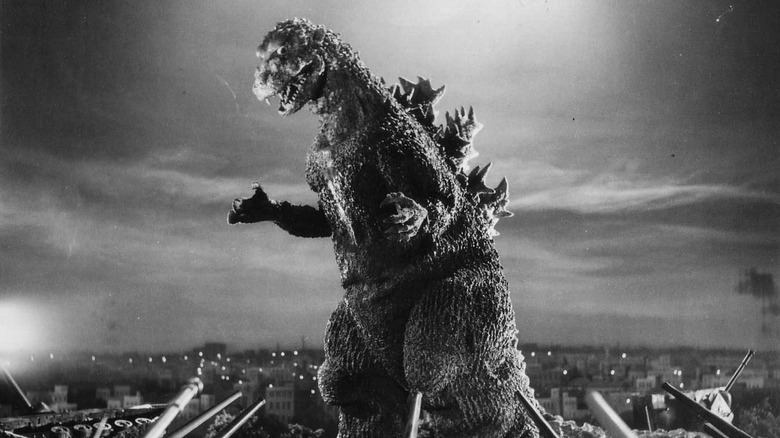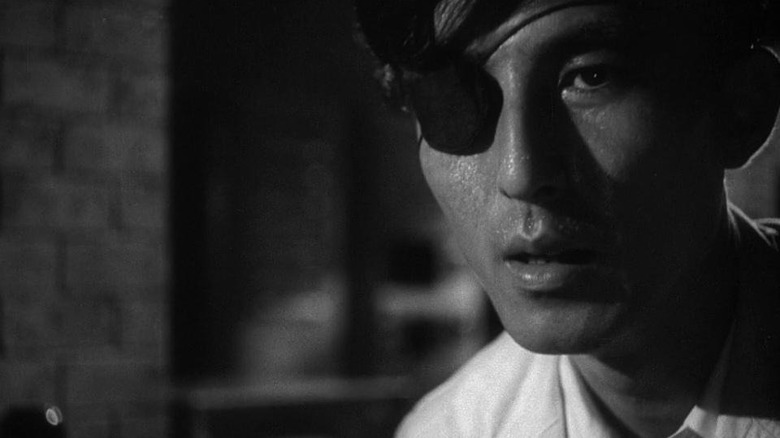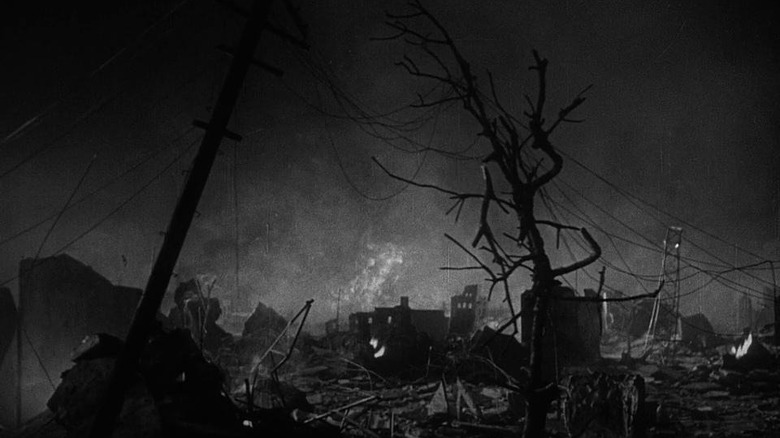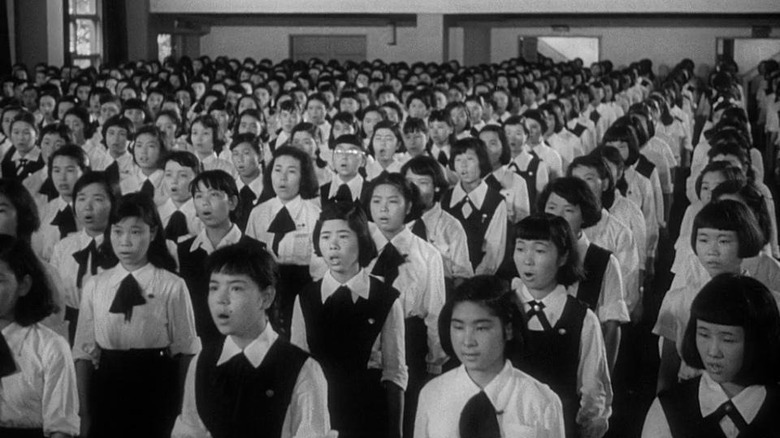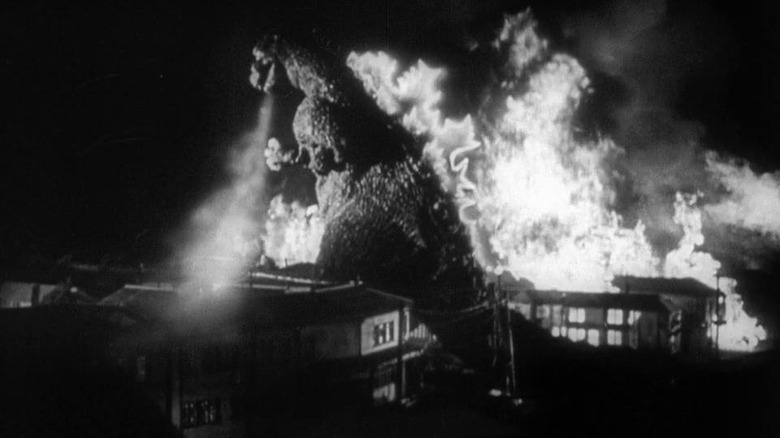The Creators Of Godzilla Felt The Weight Of The Film's Responsibility Following WWII
Once upon a time, "Gojira" was a creature of the atomic bomb. This is no longer the case. Through years of evolution, "Gojira" (or "Godzilla," as western viewers know him) drifted from nuclear anxieties. Its successors developed their own iconography: moths, plants, three-headed dragons. In the process, these monsters became inhabitants of a fantasy world drifting further and further from our own. This does not mean that new kaiju movies are bankrupt per se. The Heisei "Gamera" films of the 1990s are genre films, concerned only with being the best giant monster movies they can be. Yet they are some of the best films of their era regardless, with their own memorable characters and ideas. 2016's "Shin Gojira" reclaimed its titular monster as a political metaphor. Rather than drive audiences away, it instead became a major critical and commercial success in Japan. Kaiju still have life in them yet.
Even so, the original "Gojira" stands alone in film history. Its descendants sought to live up to its scale and imagination, and have often succeeded. Yet their fears were inherited, not ingrained. Ishiro Honda, the director of the first "Gojira," fought in World War II. He saw the grounds of Hiroshima after the atom bomb. "Gojira" is a story of resurgent nuclear anxieties in peacetime, not a Hiroshima story per se. But the bomb was never far from Honda's mind.
Starting over from scratch
Ishiro Honda wanted to direct movies more than anything. According to a Criterion Collection essay, he reneged on dental school to attend a film program at Nihon University. He found work in his early 20s at Photographic Chemical Laboratories, which would later become known as the famous film studio Toho. In 1934, when he was training to be an assistant director, Honda was called to the front by the Imperial Japanese Army to fight in China. He would be drafted again and again until 1946. By the time Honda had been discharged from the army for the last time, he had spent more time as a soldier than he ever had as a director. "When I came back," he said, "I had to start over from scratch."
Following his return to Japan, Honda proceeded to make a name for himself as an assistant director. His friend Akira Kurosawa, a successful director in his own right, came to rely upon him for his own projects. Honda's first film as a full director was 1951's "The Blue Pearl." He was 40 years old. Honda swiftly became adept at directing small-scale comedies and dramas. But it was his war films, "Eagle of the Pacific" and "Farewell Rabaul," that connected him with special effects pioneer Eiji Tsuburaya and built his own reputation as a purveyor of spectacle. Toho chose Honda to direct "Gojira," and his fate was sealed.
Not a single blade of grass
There is every chance that "Gojira" would have been a good film without Honda's involvement. The producer, Tomoyuki Tanaka, was the first to tie his B-movie premise (inspired by "The Beast from 20,000 Fathoms") to nuclear fears stoked by the recent Lucky Dragon 5 incident. Eiji Tsuburaya's special effects likely would have broken boundaries regardless of the film's script or direction. It was Honda, though, who made the decision to take "Gojira" seriously. In a 1990 interview organized by the Director's Guild of Japan, he remembers talking with Tsuburaya and Tanaka outside the studio. "When making this film," he said, "it was crucial that the crew had no doubt about what we were doing."
Honda had seen the ruins of Hiroshima while returning from the war by train. "For the next 72 years," he said, "not a single blade of grass would grow there." He would store this memory in the back of his brain together with his wartime experiences, those days of violence and disgust. Honda's military service changed the arc of his career, knocking him out of sync with fellow travelers like Kurosawa. But it also made him the perfect man to direct "Gojira," more so than perhaps even his producer Tanaka knew. Honda could not see "Gojira" as escapism. It had to be a horror story, because (as he believed, and had experienced first hand) real violence was horrific. Tanaka and Tsuburaya agreed, and the legend of "Gojira" was made.
The ghosts of all those fallen soldiers
Tanaka was not the only popular Japanese artist to channel the violence of World War II in his work. Another was Keiji Nakazawa, whose autobiographical comic "Barefoot Gen" is a foundational work of atomic literature. Nakazawa grew up in Hiroshima and lost friends and family to the bomb. After his mother died in 1966, he returned to the subject of Hiroshima in his comics. Nakazawa believed that the United States had committed a grave crime by using the atom bomb, but also that the people of Japan had not yet confronted the actions committed by the country's "militarists and ... imperial system" during World War II. As Nakazawa told The Comics Journal in a 2003 interview, the Japanese people "hadn't accepted their own responsibility for the war."
Another prominent Japanese artist who served in World War II was Shigeru Mizuki, creator of the supernatural hero Kitaro and his yokai friends. Mizuki lost his arm to a bomb, and nearly chose to remain in Papua New Guinea with his local friends rather than return to mainland Japan. He would record these experiences in "Showa," a dual memoir and history that illustrates just how the Japanese government instilled the values of fascism in its citizens through the culture of the time. His angriest work is "Onward Towards Our Noble Deaths," drawing from personal stories of surviving soldiers sent back to die in battle so that their leaders might save face. "Whenever I write a story about the war, I can't help the blind rage that surges up in me," Mizuki says in the comic's afterward. "My guess is this anger is inspired by the ghosts of all those fallen soldiers."
Something worse than Gojira
Honda was not a political radical in the same vein as Nakazawa or Mizuki. His earlier "Eagle of the Pacific" frames Japan's attack on Pearl Harbor as a tragedy that led to their defeat. But that very framing assumes a "correct means" by which Japan might have seized power across the Pacific Ocean, as if the imperial project was not driven from the start by generals and politicians eager to sacrifice the lives of others for their own personal benefit. Similarly, during a union push at Toho that led many of Honda's pogressive director friends to leave the company, Honda chose to remain neutral. According to Ed Godziszewski and Steve Ryfle in their biography "Ishiro Honda: A Life in Film, from Godzilla to Kurosawa," "his commitment was not to a political ideology but to the cause of filmmaking."
At the same time, though, Honda's perspective is right at the surface of "Gojira." The monster is a terrifying entity, its rampage through Tokyo too horrible to imagine. But the "oxygen destroyer" weapon used to defeat it is even worse. That is also the horror of the atomic bomb; not just the ashes of Hiroshima and Nagasaki, but the possibility that what comes after will cause even greater devastation. As fascism ingrains itself around the world, we would do well to remember Honda's urgency in directing "Gojira." A bigger monster, and a stronger weapon, always lies just around the corner.
